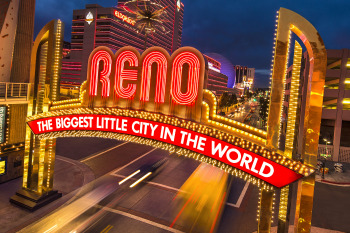October 23, 2017 | Jim Meyers
Reno embraced Nevada’s newly re-invigorated push toward cleaner energy when the city launched REENERGIZE RENO, its ambitious program to improve the efficiency of municipal, commercial, industrial and multifamily buildings by 20 percent by 2025. The move shows how local governments, coupled with forward-looking state policies, can reduce pollution, conserve water, curb climate change, and create jobs even as they help consumers and businesses save money.
REENERGIZE RENO is part of the U.S. Department of Energy’s Better Buildings Challenge, designed to cut energy waste in large buildings. Reno joins 45 pioneering cities working to boost local economies and reduce climate pollution by encouraging energy efficiency improvements in buildings. During the past six years, 345 program partners nationwide have helped save $1.9 billion in energy costs and 10 million tons of carbon emissions. Participants in various aspects of the challenge include large companies as diverse as Nissan and Arby’s, as well as Nevada itself and the nearby states of Colorado and New Mexico.
Maria Vargas, Director of the U.S. Department of Energy’s Better Buildings Challenge, joined city, business, and community leaders at theREENERGIZE RENO kickoff, held October 18 at the University of Nevada-Reno. Local leaders cited SWEEP’s studies, on the economic benefits that energy efficiency brings Nevada, when they presented the program to an audience of 80 business, government, and academic leaders at the event. In his presentation, Reno City Councilman David Bobzien noted that “investments we make in building efficiency will help create jobs and generate savings that can be spent in our local economy.”
Local leaders also cited SWEEP’s studies on the economic benefits that energy efficiency brings Nevada. To date, efficiency programs offered by Nevada’s utilities have saved enough electricity to power 230,000 typical Silver State households, returning up to $2 in benefits for every $1 invested. Importantly, from 2008 to 2016, the energy efficiency programs also conserved about 404 million gallons of water because power plants didn’t have to run their cooling systems as much. That amount equals the annual water use of about 2,270 Las Vegas area households. And saving electricity reduces the operation and pollutant emissions of fossil fuel-fired power plants, while also curbing greenhouse emissions by nearly 1.4 million metric tons, equivalent to taking about 275,000 cars from the road.
Nevada’s lawmakers and Gov. Brian Sandoval furthered the state’s energy efficiency push by enacting a series of important measures during the 2016 session, each of which passed both the Assembly and Senate by wide, bi-partisan margins.
Now, Reno’s efforts to improve the efficiency of large buildings in the city will dovetail and indeed enhance Nevada’s embrace of energy savings. REENERGIZE RENO challenges local owners and managers of commercial, industrial, and multifamily buildings to track and cut energy and water use by 20 percent by 2025. By using a baseline year of 2014, participants who already have shown leadership in energy efficiency and water conservation can earn recognition for recent investments. Participants also will be provided free access to a variety of training and networking opportunities, and recognized at an annual awards ceremony.
Among other things, city officials who back the program correctly note that improving the energy and water efficiency in large buildings will alsoproduce real financial benefits: lower operating costs, increased property values, enhanced competitive advantage and improved bottom line. What’s more, investments in cost-effective building efficiency strategies will stimulate innovation, bolster the local economy, promote a healthy environment, and create highly skilled jobs within the community. And in fact, a 2017 DOE survey found that energy efficiency already employs more than 9,500 people in Nevada.
The city itself will tackle the challenge to reduce energy and water use across its 38 municipal buildings, so already has started the process of benchmarking its energy use (using the ENERGY STAR Portfolio Manager system) and is developing a plan for reducing its own energy and water use 20 percent by 2025. Notably, the city hopes to accomplish this goal without the use of general funds, instead relying on grants, rebates, incentives, an internal revolving fund, and guaranteed energy savings performance contracts. Meanwhile, better energy efficiency will in turn reduce utility bills and maintenance costs, freeing up taxpayer-generated funds for other city priorities. City staff will document and share the funding strategies so other municipalities can use them as examples.
Modern technologies make it possible for cities and businesses to make large buildings far more efficient – and at the same time, much more comfortable – than was possible even a few years ago. By embracing a positive, pro-active strategy, Reno’s City Council and Mayor Hillary Schieve have ensured that the “biggest little city” also becomes a national leader in 21st Century energy use.



